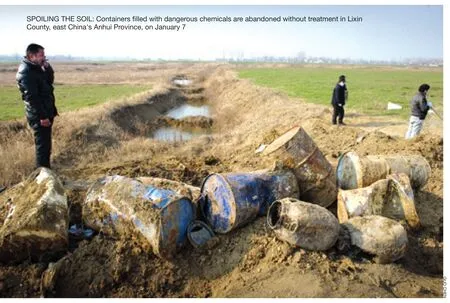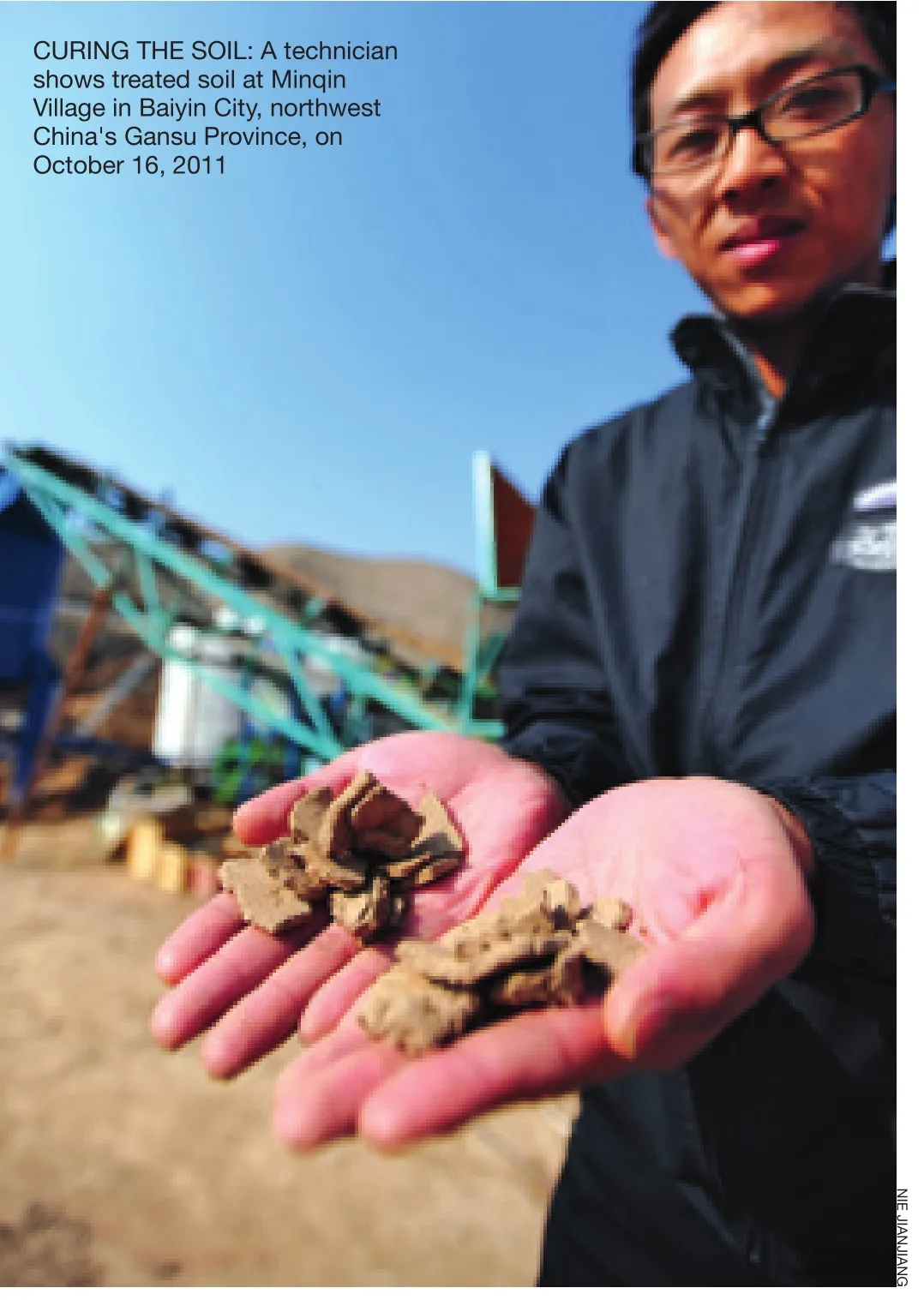Healing the Land
2012-10-14AsconcernsgrowoversoilcontaminationinurbanareassoilremediationdrawsattentionByYinPumin
As concerns grow over soil contamination in urban areas, soil remediation draws attention By Yin Pumin
Healing the Land
As concerns grow over soil contamination in urban areas, soil remediation draws attention By Yin Pumin
Despite having bought a new house in Wuhan in central China’s Hubei Province early in 2010, Zheng Hongyuan’s family remains living in a rented house located elsewhere. Like many other frustrated people who bought property in the area, Zheng lives in fear of what lies in the ground below it.
In October 2010, Zheng got the key to his new house in an affordable housing project. The compound, with 2,400 apartments, was built to meet the demand of middle- and lowincome earners. Those who were eligible to purchase the property were considered lucky.
But just as he had finished sprucing up the place and was about to move in, Zheng received news that destroyed his dreams. He learned that the new house was located on a “brownfield site,” which means that the land had previously been used for industrial or commercial purposes that had very likely left the area contaminated by hazardous waste or pollution.
Zheng later found that the plot of land had been subjected to contamination for more than 60 years, first by a pharmaceutical factory and later a chemical plant.
In 1997, after the chemical plant was closed down, a factory for manufacturing electroplating additives moved in, exposing the land to further pollution, which included numerous fluorine products.
However, during the construction of the affordable housing project where Zheng would live, the developer did not evaluate the site’s health risks at all, according to a report byThe Beijing News.
It was not until construction was almost finished in 2009 that an environmental review by the Wuhan-based China University of Geosciences discovered that the site was contaminated with antimony, a metallic element that can cause heart and lung problems, as well as with organic pollutants.
As a remedy, plastic sheeting was spread over 21,000 square meters to insulate the contaminated soil, and new soil was spread on top of the plastic. The measures cost the developer 6.8 million yuan ($1.08 million).
Local officials said the compound is now safe to live in, but some residents aren’t so sure. There are still 3,200 tons of contaminated soil buried beneath them, according toThe Beijing News.
“Living in houses built on such land can affect human health in many ways. We have seen several tragedies caused by brownfield sites worldwide,” said Gao Shengda, Editor in Chief of hjxf.net, a website focuses on environmental protection in China.
Dangerous remnants
Brownfield sites are increasing in major Chinese cities as urban sprawl has overrun many polluting factories, pushing them to new locations and leaving health risks behind.
In Beijing, more than 100 polluting factories inside the 4th Ring Road have been relocated, leaving as much as 8 million square meters of industrial land to be redeveloped. Shanghai, Chongqing, Guangzhou in southern Guangdong Province and other big cities are in a similar situation.
Such sites are often heavily contaminated because pollutants leaked into the soil during previous production processes. In some cases, the concentration of pollutants in the soil can be hundreds of times higher than regulations permit and the pollution has been documented to have penetrated as much as 10 meters into the soil in some places, according to a recent
World Bank report.
“Many brownfield sites, if not managed well, will pose an environmental and health hazard in China’s most densely populated areas, as well as an obstacle to urban and economic development,” said Jian Xie, a senior environmental specialist with the World Bank.
Soil pollution usually involves toxic heavy metals from steel, iron and smelting plants, persistent organic pollutants (POPs) from pesticide residues, organic chemical compounds from petrochemical industries, and electronic waste.
Heavy metals and POPs seldom break down over time and can accumulate in the environment. They can be absorbed into the body through drinking water and the food chain, causing harm to organs or even cancer.
Luo Yongming, a researcher with the Institute of Soil Science affiliated with the Chinese Academy of Sciences (CAS), said that soil pollution is usually more difficult to identify than pollution in water and the air. However, once the soil is contaminated, it can release toxic substances for decades.
“Redevelopment without proper remediation can be a hidden danger for people working or living on the polluted site,” Luo said. For instance, volatile substances such as benzene and formaldehyde can enter human body through breathing. And sometimes, children accidentally ingest dirt when they play on the ground.
However, the soil pollution issue did not attract public attention until 2004, when three construction workers were poisoned by toxic gas released from an old pesticide plant site as they drilled for the Songjiazhuang Subway Station in Beijing.
“There was no concept of soil remediation then,” Gao said. “The contaminated soil was just dug out and taken away. But the tragedy made everyone aware of the potential risks of industrial sites.”
An emerging business
“Soil remediation” is a collective term for various strategies that are used to purify and revitalize soil. This process of soil detoxification is part of a broader effort known as environmental remediation, which can also include efforts to purify the air and otherwise repair damage done to the ecological balance of the planet, according to Wisegeek.com.
According to a nationwide study by the Chinese Society for Environmental Sciences, at least 98,000 industrial plants were closed and relocated across the country from 2001 to 2009. The relocations left huge amounts of contaminated land, much of it in downtown urban areas, which are set to be redeveloped as commercial or public ventures.
Experts estimate that contaminated industrial sites number 300,000 to 600,000.
After the subway construction worker deaths in Beijing in 2004, soil remediation was actually introduced in China and gradually grew into a new industry. Especially in recent years, the industry has been developing at a breakneck pace and a growing number of companies are engaged in rehabilitating contaminated brownfield sites.
In 2005, the Shanghai Academy of Environmental Sciences (SAES) established the Shanghai Center for Soil Remediation. Since then, the center has completed more than 20 major projects, including the World Expo Park, as well as several subway stations large-scale soil remediation work in China. It showed that we have developed a feasible and effective method of soil remediation,” said Li Yun, Director of the Marketing Department of the SAES. She led the team that drafted the standards for evaluating the soil remediation at the World Expo Park.
In this particular zone, where a steel manufacturing factory stood, the soil was largely contaminated by heavy metals and POPs.

Li said her team used advanced solidification-stabilization technology to remove and residential compounds, which were being built on contaminated soil. More than 400,000 cubic meters of contaminated soil and 20,000 tons of underground water were treated.
The center is working on comprehensive remediation for the Shanghai Disneyland project in the city’s Pudong New Area and the Nanda area development project in Baoshan District, which involves 1,000 factories being shut down over the next five years to make room for residential compounds.
“The World Expo project was the first the heavy metals from the soil and bio-pile technology to clean POPs. “The remediation proved very successful,” Li said.
The standards drafted by Li’s team were later submitted to the Ministry of Environmental Protection and officially published as the country’s first remediation standards in the Standard of Soil Quality Assessment for Exhibition Sites published in 2007.
Statistics released by hjxf.net showed that more than 20 new land remediation companies were registered in China in 2011.
During an environmental industry forum held on March 20-21 in Beijing, Gao with hjxf.net predicted that the market value of soil remediation in China would be as high as 40 billion yuan ($6.35 billion) by 2015. “The urbanization rate in China is only about 50 percent. Therefore, 40 billion yuan is just a rough estimate,” he said.
According to the World Bank report, in China, most soil remediation projects cost more than 100 million yuan ($15.87 million) each.
In 2009, southwest China’s Chongqing spent 800 million yuan ($126.98 million) assessing the contamination of 45 lots of land, and the cost of cleaning up the land is expected to exceed 2 billion yuan ($317.38 million).
Last year in Beijing, a massive remediation project cost more than 700 million yuan ($111.11 million), the most that has been spent on single remediation project in China.
Given its breakneck growth, more money is flowing in. At the end of 2011, Sequoia Capital, a U.S. venture capital firm based in California, invested in a Beijing-based environmental remediation company secretly, said the Guangzhou-basedSouthern Weekend.
On February 21, BCEG Environmental Remediation Co. Ltd., a wholly owned subsidiary of Beijing Construction Engineering Group, announced its bid to go public. The company said on its website that it had undertaken 80 percent of soil remediation projects in China.
Meanwhile, China’s heavy demand for soil remediation has also created a lot of work for many research institutes of environmental sciences, which assess pollution levels and work out detoxification programs.
Zhao Hualin, Director of the Department of Total Pollutants Control of the Ministry of Environmental Protection, believes that soil and underground water remediation will be-come a new source of environmental industry growth in 2016-20.
Difficulties still many
“Despite the growing demand, however, there are only a few specialized institutions in the field,” said Huang Shenfa, Deputy Director of SAES, which carries out most of the soil remediation projects in the city. Sometimes the academy was “too busy to handle some projects,” according to Huang.
“Contaminated industrial sites are usually found downtown and are always being sought by real estate developers. It is a concern when management policies and regulations are lax,”said Shen Jianhua, a senior researcher with the Shanghai Institute for Biological Sciences under the CAS.
He said that over the past 20 years, because of the rapid development of the economy and human activities, environmental pollution has become more complex. Pollution now comes from multiple sources, and that makes remediation efforts even more difficult.
“We lack detailed laws and national standards that give a clear guideline for which kinds of soil need repairing, how deep the remediation should go and who should supervise this,” Shen said.
Under such conditions, there have been no unified standards concerning pricing and clean-up technologies, and as of today no companies in the industry have disclosed their cost structures for remediation, said theSouthern Weekend.
The cost of detoxifying a piece of land is difficult to estimate because no one knows what pollutants lie deep underground before it is excavated, said the report. Moreover, the shorter the time allotted to the cleaners to complete their job is, the higher the charge is.
Currently, remediation technologies in China remain underdeveloped. Most cleaners simply excavate, remove the contaminated soil and dump it elsewhere without neutralizing the poisonous elements, even though many new technologies have been employed in many Western countries.
For example, since China lacks specialized facilities to treat polluted soil and has only a limited number of proper wastedisposal sites, most of the contaminated soil is incinerated in cement kilns, a process that produces highly poisonous waste gases such as dioxin.

Ma Jun, a technical director at the BCEG Environmental Remediation Co. Ltd., said that such kilns are not equipped with facilities to process the exhaust gas, making the secondary pollutants a worse threat than primary ones.
According to Jiang Lin, Deputy Director of the Beijing Municipal Research Institute of Environmental Protection, China has pioneered dozens of sophisticated methods concerning soil remediation, but none of them has been put into use so far.
Many Chinese remediation companies are still in their infancy, making cleaner technologies difficult to implement, explained Liao Xiaoyong, Vice Director of the Institute of Geographic Sciences and Natural Resources Research affiliated to the CAS.
“Some remediation companies were only established because there was market demand and they don’t have the essential equipment or technologies,” Liao added.
Given the pressure to develop commercial or residential areas as quickly as possible to make higher profits, there isn’t time to do real technical remediation on sites, as this can add several years to project times, said theSouthern Weekend.
Statistics from the BCEG Environmental Remediation show that almost all remediation projects have been required to be finished within two years. As a result, many of the projects can only apply incineration or digand-dump technologies.
Additionally, real estate developers want to keep remediation costs as low as possible, which also prevents environmental companies from using more sophisticated methods.
Some developers argue that they should not pay all the costs of remediation because they didn’t cause the pollution.
Wang Shuyi, Director of the Research Institute of Environmental Law at Wuhan University in Wuhan, Hubei, said that original polluters should pay for the remediation. In cases where it’s impossible to identify who’s liable, he suggested the money should come from public funding.
The World Bank report recommended using economic measures such as loans, dedicated subsidies and environment taxes to support the clean-up of toxic sites. Another possibility, used in many Western countries, is setting up a superfund; stakeholders put in money every year to support remediation.
